Nursing Care of the Family: Assessment, Planning, Implementation and Evaluation
VerifiedAdded on 2023/06/08
|12
|3050
|197
AI Summary
This article discusses nursing care for families, including assessment, planning, implementation, and evaluation. It covers issues such as social isolation and poor eating habits, and provides interventions and resources to address them.
Contribute Materials
Your contribution can guide someone’s learning journey. Share your
documents today.
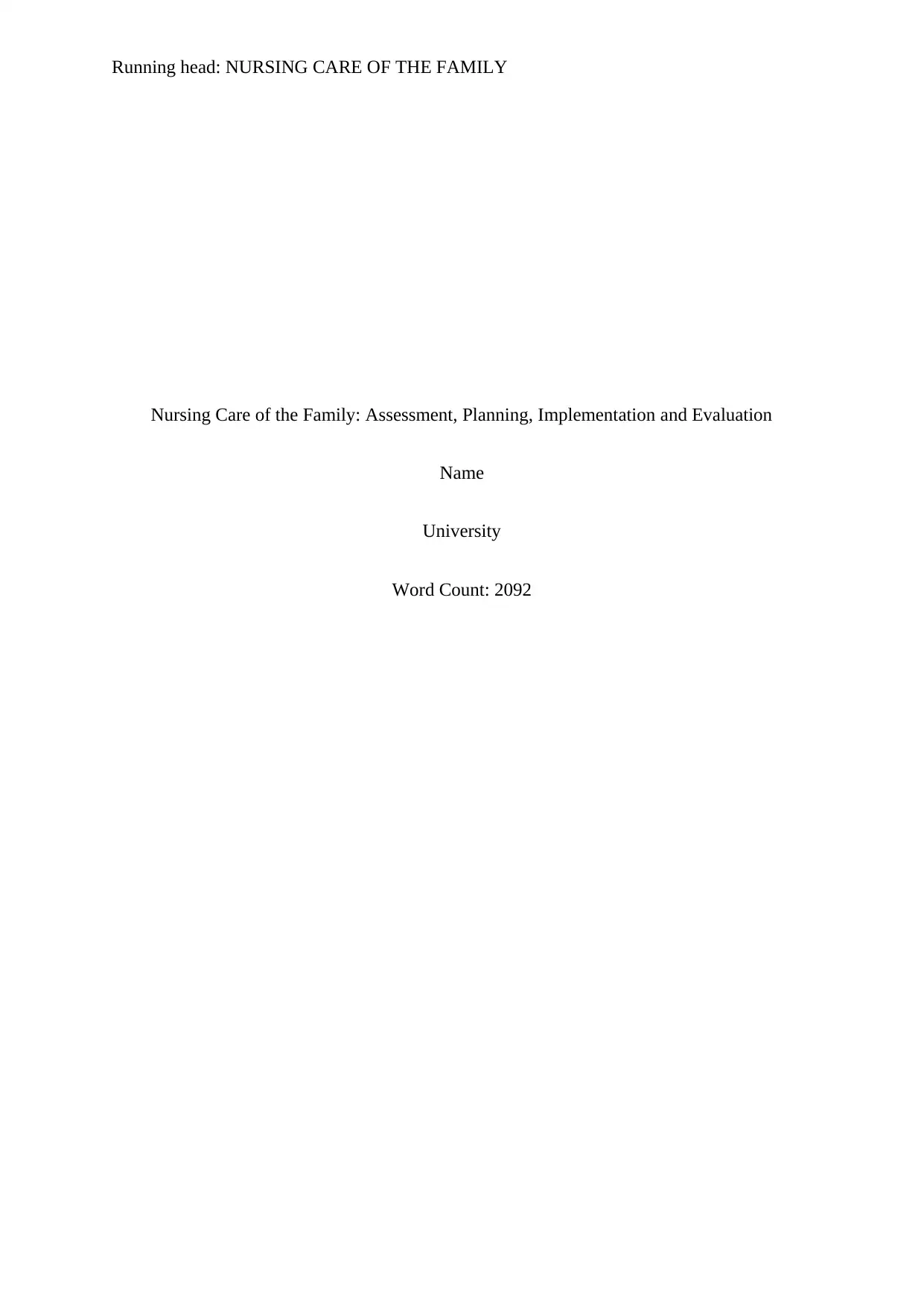
Running head: NURSING CARE OF THE FAMILY
Nursing Care of the Family: Assessment, Planning, Implementation and Evaluation
Name
University
Word Count: 2092
Nursing Care of the Family: Assessment, Planning, Implementation and Evaluation
Name
University
Word Count: 2092
Secure Best Marks with AI Grader
Need help grading? Try our AI Grader for instant feedback on your assignments.
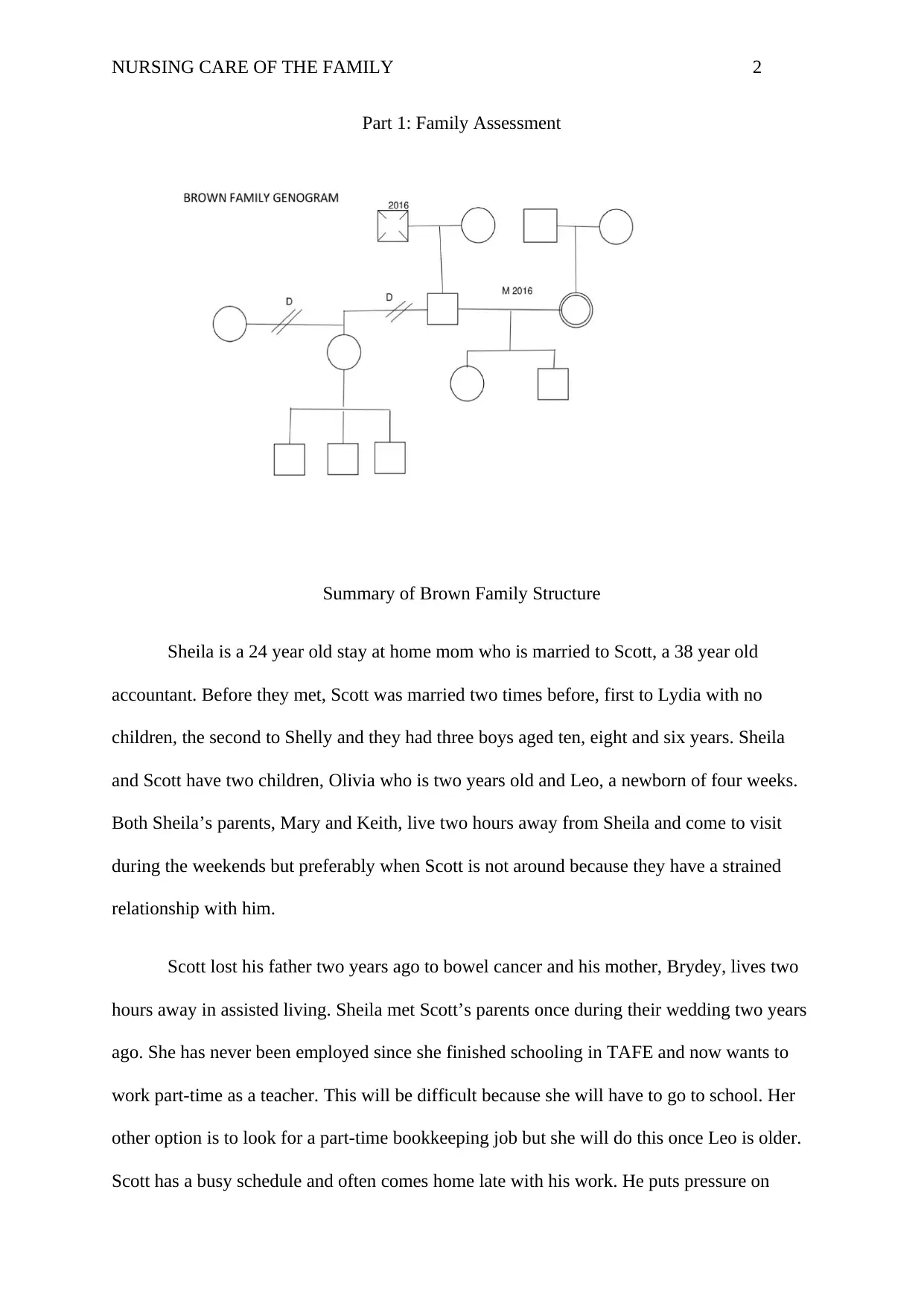
NURSING CARE OF THE FAMILY 2
Part 1: Family Assessment
Summary of Brown Family Structure
Sheila is a 24 year old stay at home mom who is married to Scott, a 38 year old
accountant. Before they met, Scott was married two times before, first to Lydia with no
children, the second to Shelly and they had three boys aged ten, eight and six years. Sheila
and Scott have two children, Olivia who is two years old and Leo, a newborn of four weeks.
Both Sheila’s parents, Mary and Keith, live two hours away from Sheila and come to visit
during the weekends but preferably when Scott is not around because they have a strained
relationship with him.
Scott lost his father two years ago to bowel cancer and his mother, Brydey, lives two
hours away in assisted living. Sheila met Scott’s parents once during their wedding two years
ago. She has never been employed since she finished schooling in TAFE and now wants to
work part-time as a teacher. This will be difficult because she will have to go to school. Her
other option is to look for a part-time bookkeeping job but she will do this once Leo is older.
Scott has a busy schedule and often comes home late with his work. He puts pressure on
Part 1: Family Assessment
Summary of Brown Family Structure
Sheila is a 24 year old stay at home mom who is married to Scott, a 38 year old
accountant. Before they met, Scott was married two times before, first to Lydia with no
children, the second to Shelly and they had three boys aged ten, eight and six years. Sheila
and Scott have two children, Olivia who is two years old and Leo, a newborn of four weeks.
Both Sheila’s parents, Mary and Keith, live two hours away from Sheila and come to visit
during the weekends but preferably when Scott is not around because they have a strained
relationship with him.
Scott lost his father two years ago to bowel cancer and his mother, Brydey, lives two
hours away in assisted living. Sheila met Scott’s parents once during their wedding two years
ago. She has never been employed since she finished schooling in TAFE and now wants to
work part-time as a teacher. This will be difficult because she will have to go to school. Her
other option is to look for a part-time bookkeeping job but she will do this once Leo is older.
Scott has a busy schedule and often comes home late with his work. He puts pressure on
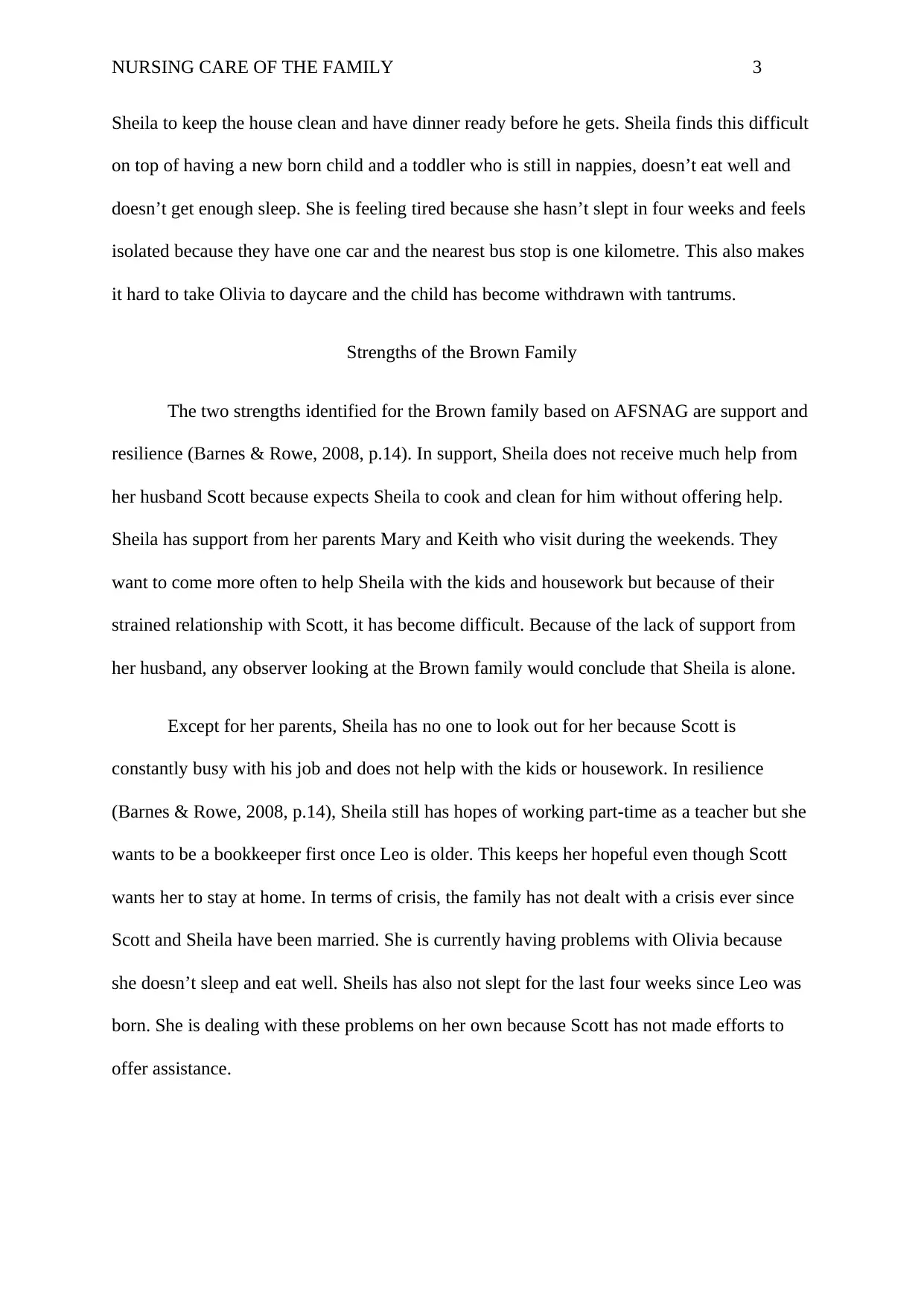
NURSING CARE OF THE FAMILY 3
Sheila to keep the house clean and have dinner ready before he gets. Sheila finds this difficult
on top of having a new born child and a toddler who is still in nappies, doesn’t eat well and
doesn’t get enough sleep. She is feeling tired because she hasn’t slept in four weeks and feels
isolated because they have one car and the nearest bus stop is one kilometre. This also makes
it hard to take Olivia to daycare and the child has become withdrawn with tantrums.
Strengths of the Brown Family
The two strengths identified for the Brown family based on AFSNAG are support and
resilience (Barnes & Rowe, 2008, p.14). In support, Sheila does not receive much help from
her husband Scott because expects Sheila to cook and clean for him without offering help.
Sheila has support from her parents Mary and Keith who visit during the weekends. They
want to come more often to help Sheila with the kids and housework but because of their
strained relationship with Scott, it has become difficult. Because of the lack of support from
her husband, any observer looking at the Brown family would conclude that Sheila is alone.
Except for her parents, Sheila has no one to look out for her because Scott is
constantly busy with his job and does not help with the kids or housework. In resilience
(Barnes & Rowe, 2008, p.14), Sheila still has hopes of working part-time as a teacher but she
wants to be a bookkeeper first once Leo is older. This keeps her hopeful even though Scott
wants her to stay at home. In terms of crisis, the family has not dealt with a crisis ever since
Scott and Sheila have been married. She is currently having problems with Olivia because
she doesn’t sleep and eat well. Sheils has also not slept for the last four weeks since Leo was
born. She is dealing with these problems on her own because Scott has not made efforts to
offer assistance.
Sheila to keep the house clean and have dinner ready before he gets. Sheila finds this difficult
on top of having a new born child and a toddler who is still in nappies, doesn’t eat well and
doesn’t get enough sleep. She is feeling tired because she hasn’t slept in four weeks and feels
isolated because they have one car and the nearest bus stop is one kilometre. This also makes
it hard to take Olivia to daycare and the child has become withdrawn with tantrums.
Strengths of the Brown Family
The two strengths identified for the Brown family based on AFSNAG are support and
resilience (Barnes & Rowe, 2008, p.14). In support, Sheila does not receive much help from
her husband Scott because expects Sheila to cook and clean for him without offering help.
Sheila has support from her parents Mary and Keith who visit during the weekends. They
want to come more often to help Sheila with the kids and housework but because of their
strained relationship with Scott, it has become difficult. Because of the lack of support from
her husband, any observer looking at the Brown family would conclude that Sheila is alone.
Except for her parents, Sheila has no one to look out for her because Scott is
constantly busy with his job and does not help with the kids or housework. In resilience
(Barnes & Rowe, 2008, p.14), Sheila still has hopes of working part-time as a teacher but she
wants to be a bookkeeper first once Leo is older. This keeps her hopeful even though Scott
wants her to stay at home. In terms of crisis, the family has not dealt with a crisis ever since
Scott and Sheila have been married. She is currently having problems with Olivia because
she doesn’t sleep and eat well. Sheils has also not slept for the last four weeks since Leo was
born. She is dealing with these problems on her own because Scott has not made efforts to
offer assistance.
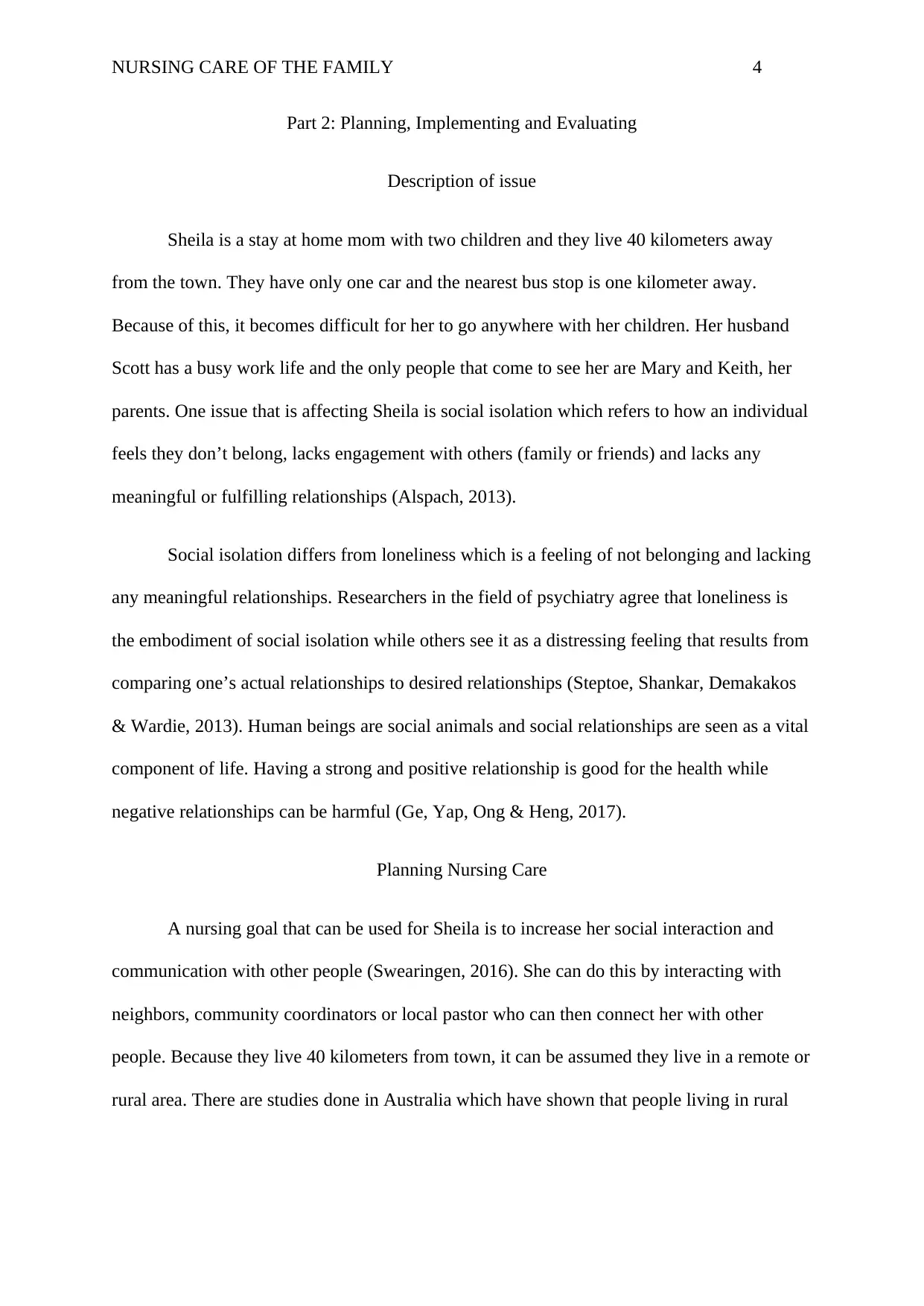
NURSING CARE OF THE FAMILY 4
Part 2: Planning, Implementing and Evaluating
Description of issue
Sheila is a stay at home mom with two children and they live 40 kilometers away
from the town. They have only one car and the nearest bus stop is one kilometer away.
Because of this, it becomes difficult for her to go anywhere with her children. Her husband
Scott has a busy work life and the only people that come to see her are Mary and Keith, her
parents. One issue that is affecting Sheila is social isolation which refers to how an individual
feels they don’t belong, lacks engagement with others (family or friends) and lacks any
meaningful or fulfilling relationships (Alspach, 2013).
Social isolation differs from loneliness which is a feeling of not belonging and lacking
any meaningful relationships. Researchers in the field of psychiatry agree that loneliness is
the embodiment of social isolation while others see it as a distressing feeling that results from
comparing one’s actual relationships to desired relationships (Steptoe, Shankar, Demakakos
& Wardie, 2013). Human beings are social animals and social relationships are seen as a vital
component of life. Having a strong and positive relationship is good for the health while
negative relationships can be harmful (Ge, Yap, Ong & Heng, 2017).
Planning Nursing Care
A nursing goal that can be used for Sheila is to increase her social interaction and
communication with other people (Swearingen, 2016). She can do this by interacting with
neighbors, community coordinators or local pastor who can then connect her with other
people. Because they live 40 kilometers from town, it can be assumed they live in a remote or
rural area. There are studies done in Australia which have shown that people living in rural
Part 2: Planning, Implementing and Evaluating
Description of issue
Sheila is a stay at home mom with two children and they live 40 kilometers away
from the town. They have only one car and the nearest bus stop is one kilometer away.
Because of this, it becomes difficult for her to go anywhere with her children. Her husband
Scott has a busy work life and the only people that come to see her are Mary and Keith, her
parents. One issue that is affecting Sheila is social isolation which refers to how an individual
feels they don’t belong, lacks engagement with others (family or friends) and lacks any
meaningful or fulfilling relationships (Alspach, 2013).
Social isolation differs from loneliness which is a feeling of not belonging and lacking
any meaningful relationships. Researchers in the field of psychiatry agree that loneliness is
the embodiment of social isolation while others see it as a distressing feeling that results from
comparing one’s actual relationships to desired relationships (Steptoe, Shankar, Demakakos
& Wardie, 2013). Human beings are social animals and social relationships are seen as a vital
component of life. Having a strong and positive relationship is good for the health while
negative relationships can be harmful (Ge, Yap, Ong & Heng, 2017).
Planning Nursing Care
A nursing goal that can be used for Sheila is to increase her social interaction and
communication with other people (Swearingen, 2016). She can do this by interacting with
neighbors, community coordinators or local pastor who can then connect her with other
people. Because they live 40 kilometers from town, it can be assumed they live in a remote or
rural area. There are studies done in Australia which have shown that people living in rural
Secure Best Marks with AI Grader
Need help grading? Try our AI Grader for instant feedback on your assignments.
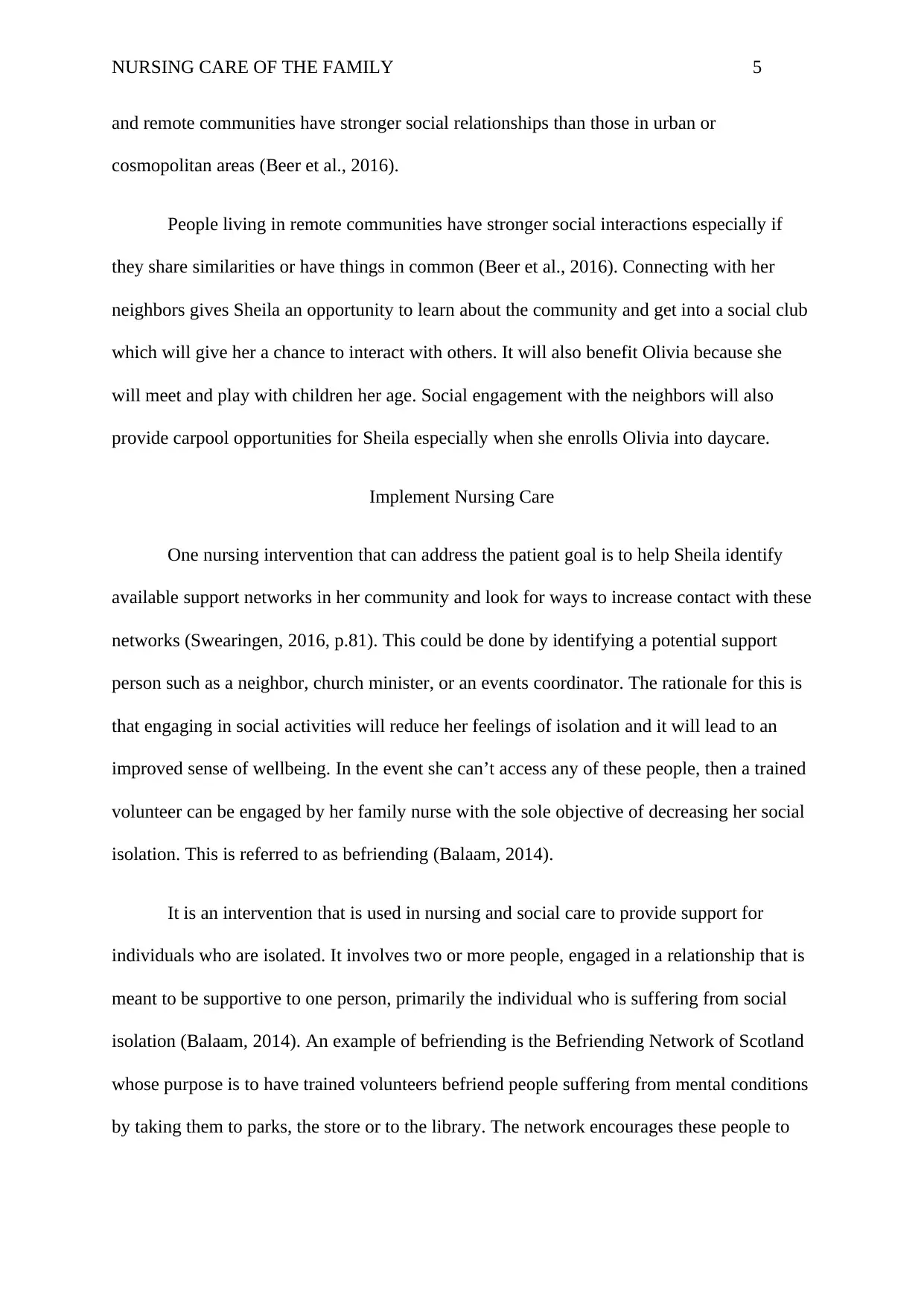
NURSING CARE OF THE FAMILY 5
and remote communities have stronger social relationships than those in urban or
cosmopolitan areas (Beer et al., 2016).
People living in remote communities have stronger social interactions especially if
they share similarities or have things in common (Beer et al., 2016). Connecting with her
neighbors gives Sheila an opportunity to learn about the community and get into a social club
which will give her a chance to interact with others. It will also benefit Olivia because she
will meet and play with children her age. Social engagement with the neighbors will also
provide carpool opportunities for Sheila especially when she enrolls Olivia into daycare.
Implement Nursing Care
One nursing intervention that can address the patient goal is to help Sheila identify
available support networks in her community and look for ways to increase contact with these
networks (Swearingen, 2016, p.81). This could be done by identifying a potential support
person such as a neighbor, church minister, or an events coordinator. The rationale for this is
that engaging in social activities will reduce her feelings of isolation and it will lead to an
improved sense of wellbeing. In the event she can’t access any of these people, then a trained
volunteer can be engaged by her family nurse with the sole objective of decreasing her social
isolation. This is referred to as befriending (Balaam, 2014).
It is an intervention that is used in nursing and social care to provide support for
individuals who are isolated. It involves two or more people, engaged in a relationship that is
meant to be supportive to one person, primarily the individual who is suffering from social
isolation (Balaam, 2014). An example of befriending is the Befriending Network of Scotland
whose purpose is to have trained volunteers befriend people suffering from mental conditions
by taking them to parks, the store or to the library. The network encourages these people to
and remote communities have stronger social relationships than those in urban or
cosmopolitan areas (Beer et al., 2016).
People living in remote communities have stronger social interactions especially if
they share similarities or have things in common (Beer et al., 2016). Connecting with her
neighbors gives Sheila an opportunity to learn about the community and get into a social club
which will give her a chance to interact with others. It will also benefit Olivia because she
will meet and play with children her age. Social engagement with the neighbors will also
provide carpool opportunities for Sheila especially when she enrolls Olivia into daycare.
Implement Nursing Care
One nursing intervention that can address the patient goal is to help Sheila identify
available support networks in her community and look for ways to increase contact with these
networks (Swearingen, 2016, p.81). This could be done by identifying a potential support
person such as a neighbor, church minister, or an events coordinator. The rationale for this is
that engaging in social activities will reduce her feelings of isolation and it will lead to an
improved sense of wellbeing. In the event she can’t access any of these people, then a trained
volunteer can be engaged by her family nurse with the sole objective of decreasing her social
isolation. This is referred to as befriending (Balaam, 2014).
It is an intervention that is used in nursing and social care to provide support for
individuals who are isolated. It involves two or more people, engaged in a relationship that is
meant to be supportive to one person, primarily the individual who is suffering from social
isolation (Balaam, 2014). An example of befriending is the Befriending Network of Scotland
whose purpose is to have trained volunteers befriend people suffering from mental conditions
by taking them to parks, the store or to the library. The network encourages these people to
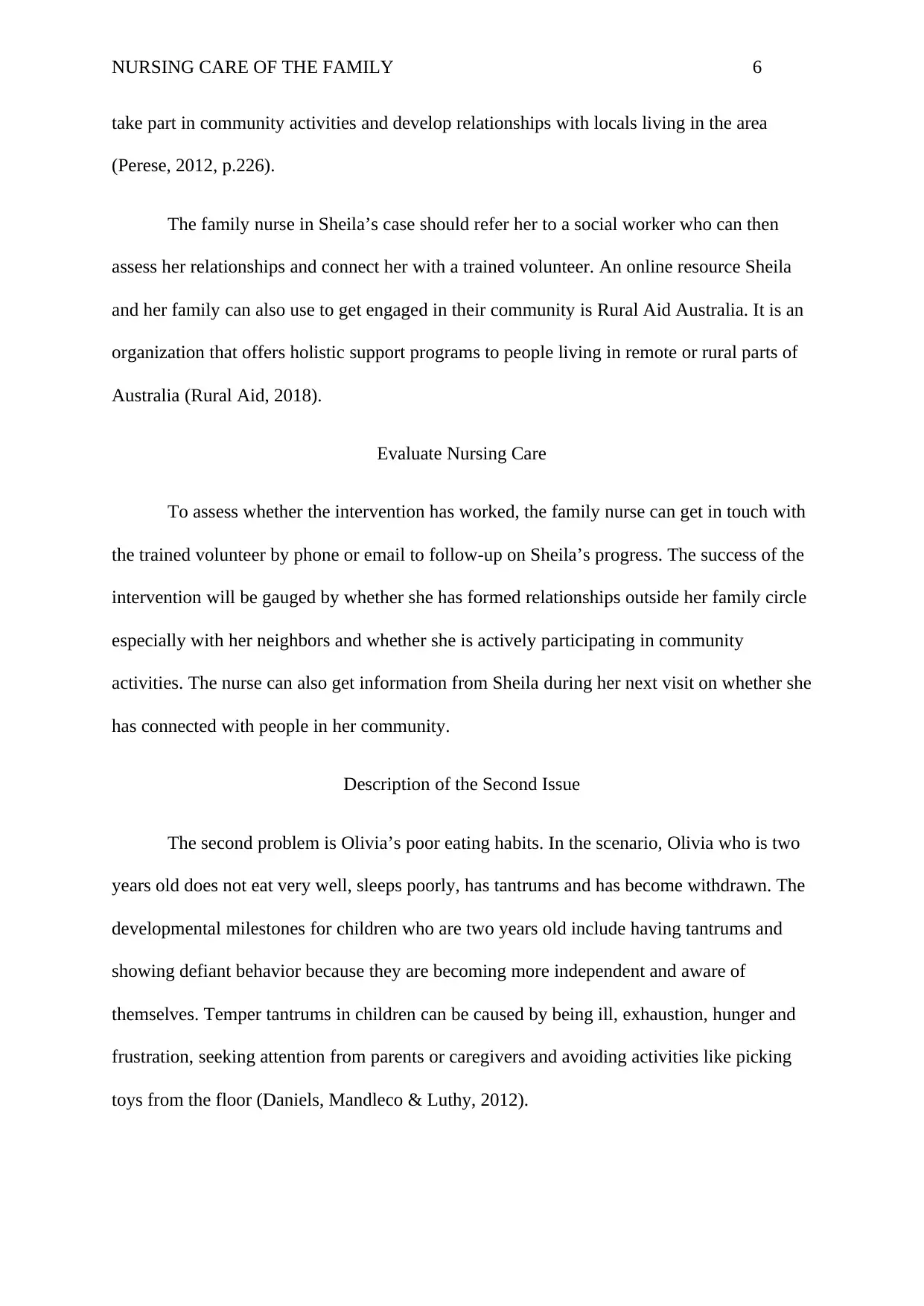
NURSING CARE OF THE FAMILY 6
take part in community activities and develop relationships with locals living in the area
(Perese, 2012, p.226).
The family nurse in Sheila’s case should refer her to a social worker who can then
assess her relationships and connect her with a trained volunteer. An online resource Sheila
and her family can also use to get engaged in their community is Rural Aid Australia. It is an
organization that offers holistic support programs to people living in remote or rural parts of
Australia (Rural Aid, 2018).
Evaluate Nursing Care
To assess whether the intervention has worked, the family nurse can get in touch with
the trained volunteer by phone or email to follow-up on Sheila’s progress. The success of the
intervention will be gauged by whether she has formed relationships outside her family circle
especially with her neighbors and whether she is actively participating in community
activities. The nurse can also get information from Sheila during her next visit on whether she
has connected with people in her community.
Description of the Second Issue
The second problem is Olivia’s poor eating habits. In the scenario, Olivia who is two
years old does not eat very well, sleeps poorly, has tantrums and has become withdrawn. The
developmental milestones for children who are two years old include having tantrums and
showing defiant behavior because they are becoming more independent and aware of
themselves. Temper tantrums in children can be caused by being ill, exhaustion, hunger and
frustration, seeking attention from parents or caregivers and avoiding activities like picking
toys from the floor (Daniels, Mandleco & Luthy, 2012).
take part in community activities and develop relationships with locals living in the area
(Perese, 2012, p.226).
The family nurse in Sheila’s case should refer her to a social worker who can then
assess her relationships and connect her with a trained volunteer. An online resource Sheila
and her family can also use to get engaged in their community is Rural Aid Australia. It is an
organization that offers holistic support programs to people living in remote or rural parts of
Australia (Rural Aid, 2018).
Evaluate Nursing Care
To assess whether the intervention has worked, the family nurse can get in touch with
the trained volunteer by phone or email to follow-up on Sheila’s progress. The success of the
intervention will be gauged by whether she has formed relationships outside her family circle
especially with her neighbors and whether she is actively participating in community
activities. The nurse can also get information from Sheila during her next visit on whether she
has connected with people in her community.
Description of the Second Issue
The second problem is Olivia’s poor eating habits. In the scenario, Olivia who is two
years old does not eat very well, sleeps poorly, has tantrums and has become withdrawn. The
developmental milestones for children who are two years old include having tantrums and
showing defiant behavior because they are becoming more independent and aware of
themselves. Temper tantrums in children can be caused by being ill, exhaustion, hunger and
frustration, seeking attention from parents or caregivers and avoiding activities like picking
toys from the floor (Daniels, Mandleco & Luthy, 2012).

NURSING CARE OF THE FAMILY 7
During the early years of their life, children tend to have erratic eating habits although
these vary for every child. After their infancy, toddlers face a period of rapid growth spurts
which are characterized by decreased appetite and sporadic periods of eating (Linnard-
Palmer, 2019). They also develop a sense of autonomy at this stage and become selective in
the type of food they want to eat. For some children, refusing to eat might be a form of
attention seeking behavior and an indicator of a difficult parent-child relationship. For others,
their decision to eat might be influenced by copying their parents or role models food
preferences (Leung, Marchand & Sauve, 2012).
Planning Nursing Care
A nursing care goal that can be used for Olivia is that she will be able to eat three
square meals in a day by the end of two weeks. Sheila needs to keep a journal that documents
Olivia’s eating patterns over the course of the two weeks. The reasons for this nursing goal is
that children Olivia’s age tend to have poor appetites and eating habits because of slowing
growth rates after the infancy period, an increasing sense of independence, preferring to
select their own meals, psychological changes that might affect their dietary intakes and an
increasing preference to self-feed (Walton, Kuczynski, Haycraft, Breen & Haines, 2017).
According to the American Academy of Pediatrics (Healthy Children, 2017), two
year-old children should be eating three healthy meals in a day and one or two snacks.
Because they are cognitively developed, toddlers can become active participants during meal
times without prodding. Having three meals that are balanced is also important preventing
nutritional deficiencies such as iron deficiency which many healthcare providers have now
started screening toddlers for (Linnard-Palmer, 2019, p.91).
During the early years of their life, children tend to have erratic eating habits although
these vary for every child. After their infancy, toddlers face a period of rapid growth spurts
which are characterized by decreased appetite and sporadic periods of eating (Linnard-
Palmer, 2019). They also develop a sense of autonomy at this stage and become selective in
the type of food they want to eat. For some children, refusing to eat might be a form of
attention seeking behavior and an indicator of a difficult parent-child relationship. For others,
their decision to eat might be influenced by copying their parents or role models food
preferences (Leung, Marchand & Sauve, 2012).
Planning Nursing Care
A nursing care goal that can be used for Olivia is that she will be able to eat three
square meals in a day by the end of two weeks. Sheila needs to keep a journal that documents
Olivia’s eating patterns over the course of the two weeks. The reasons for this nursing goal is
that children Olivia’s age tend to have poor appetites and eating habits because of slowing
growth rates after the infancy period, an increasing sense of independence, preferring to
select their own meals, psychological changes that might affect their dietary intakes and an
increasing preference to self-feed (Walton, Kuczynski, Haycraft, Breen & Haines, 2017).
According to the American Academy of Pediatrics (Healthy Children, 2017), two
year-old children should be eating three healthy meals in a day and one or two snacks.
Because they are cognitively developed, toddlers can become active participants during meal
times without prodding. Having three meals that are balanced is also important preventing
nutritional deficiencies such as iron deficiency which many healthcare providers have now
started screening toddlers for (Linnard-Palmer, 2019, p.91).
Paraphrase This Document
Need a fresh take? Get an instant paraphrase of this document with our AI Paraphraser
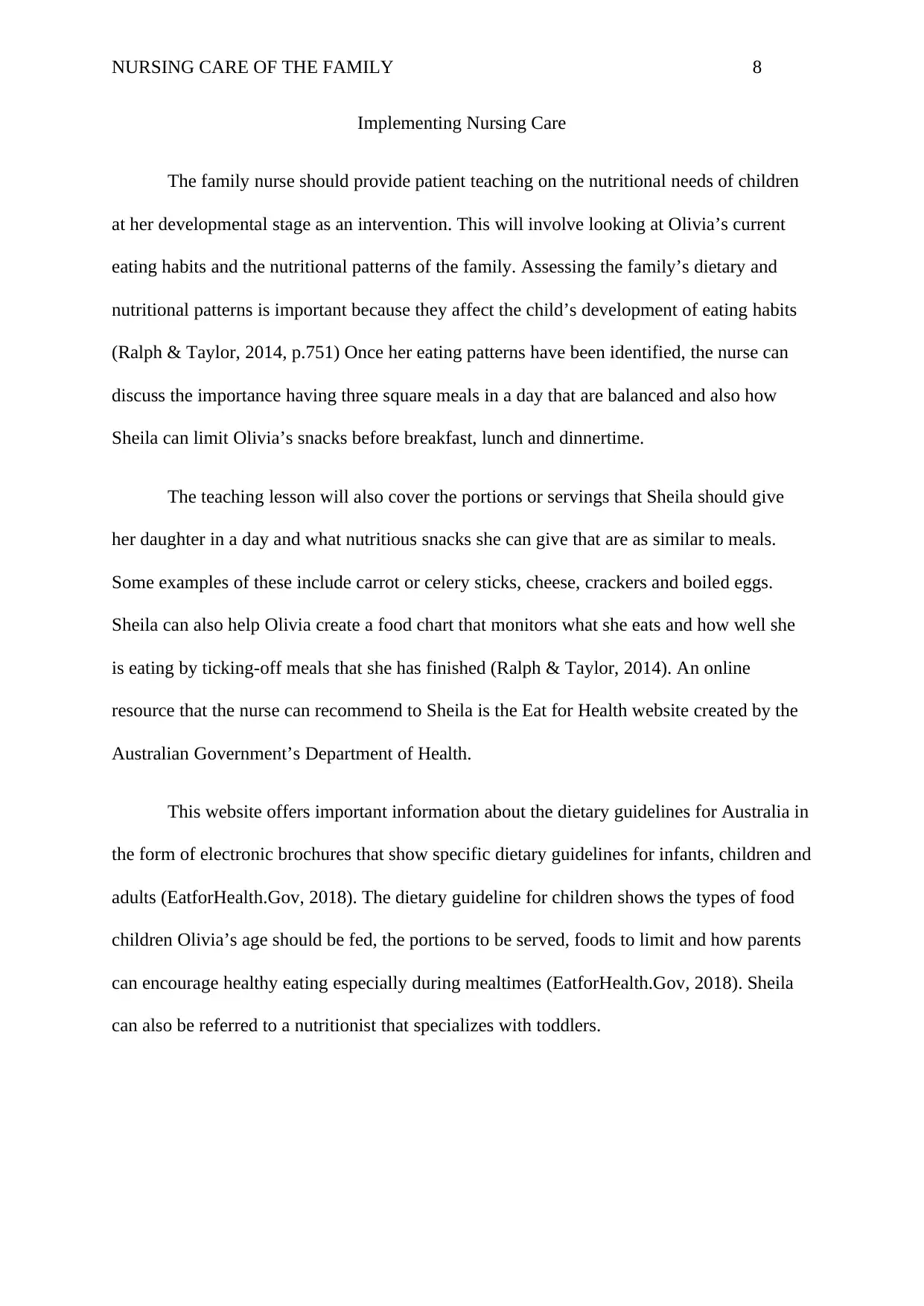
NURSING CARE OF THE FAMILY 8
Implementing Nursing Care
The family nurse should provide patient teaching on the nutritional needs of children
at her developmental stage as an intervention. This will involve looking at Olivia’s current
eating habits and the nutritional patterns of the family. Assessing the family’s dietary and
nutritional patterns is important because they affect the child’s development of eating habits
(Ralph & Taylor, 2014, p.751) Once her eating patterns have been identified, the nurse can
discuss the importance having three square meals in a day that are balanced and also how
Sheila can limit Olivia’s snacks before breakfast, lunch and dinnertime.
The teaching lesson will also cover the portions or servings that Sheila should give
her daughter in a day and what nutritious snacks she can give that are as similar to meals.
Some examples of these include carrot or celery sticks, cheese, crackers and boiled eggs.
Sheila can also help Olivia create a food chart that monitors what she eats and how well she
is eating by ticking-off meals that she has finished (Ralph & Taylor, 2014). An online
resource that the nurse can recommend to Sheila is the Eat for Health website created by the
Australian Government’s Department of Health.
This website offers important information about the dietary guidelines for Australia in
the form of electronic brochures that show specific dietary guidelines for infants, children and
adults (EatforHealth.Gov, 2018). The dietary guideline for children shows the types of food
children Olivia’s age should be fed, the portions to be served, foods to limit and how parents
can encourage healthy eating especially during mealtimes (EatforHealth.Gov, 2018). Sheila
can also be referred to a nutritionist that specializes with toddlers.
Implementing Nursing Care
The family nurse should provide patient teaching on the nutritional needs of children
at her developmental stage as an intervention. This will involve looking at Olivia’s current
eating habits and the nutritional patterns of the family. Assessing the family’s dietary and
nutritional patterns is important because they affect the child’s development of eating habits
(Ralph & Taylor, 2014, p.751) Once her eating patterns have been identified, the nurse can
discuss the importance having three square meals in a day that are balanced and also how
Sheila can limit Olivia’s snacks before breakfast, lunch and dinnertime.
The teaching lesson will also cover the portions or servings that Sheila should give
her daughter in a day and what nutritious snacks she can give that are as similar to meals.
Some examples of these include carrot or celery sticks, cheese, crackers and boiled eggs.
Sheila can also help Olivia create a food chart that monitors what she eats and how well she
is eating by ticking-off meals that she has finished (Ralph & Taylor, 2014). An online
resource that the nurse can recommend to Sheila is the Eat for Health website created by the
Australian Government’s Department of Health.
This website offers important information about the dietary guidelines for Australia in
the form of electronic brochures that show specific dietary guidelines for infants, children and
adults (EatforHealth.Gov, 2018). The dietary guideline for children shows the types of food
children Olivia’s age should be fed, the portions to be served, foods to limit and how parents
can encourage healthy eating especially during mealtimes (EatforHealth.Gov, 2018). Sheila
can also be referred to a nutritionist that specializes with toddlers.
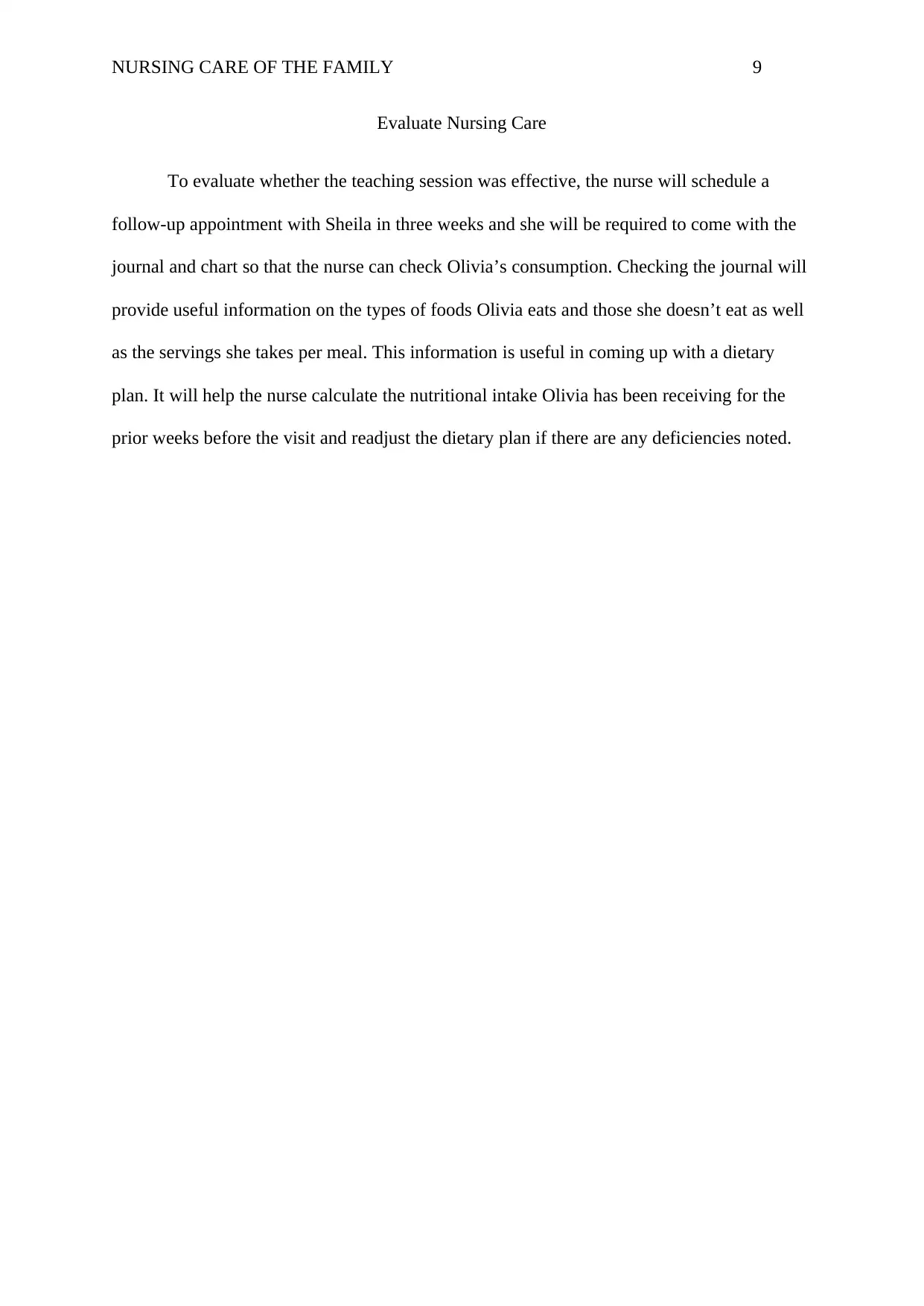
NURSING CARE OF THE FAMILY 9
Evaluate Nursing Care
To evaluate whether the teaching session was effective, the nurse will schedule a
follow-up appointment with Sheila in three weeks and she will be required to come with the
journal and chart so that the nurse can check Olivia’s consumption. Checking the journal will
provide useful information on the types of foods Olivia eats and those she doesn’t eat as well
as the servings she takes per meal. This information is useful in coming up with a dietary
plan. It will help the nurse calculate the nutritional intake Olivia has been receiving for the
prior weeks before the visit and readjust the dietary plan if there are any deficiencies noted.
Evaluate Nursing Care
To evaluate whether the teaching session was effective, the nurse will schedule a
follow-up appointment with Sheila in three weeks and she will be required to come with the
journal and chart so that the nurse can check Olivia’s consumption. Checking the journal will
provide useful information on the types of foods Olivia eats and those she doesn’t eat as well
as the servings she takes per meal. This information is useful in coming up with a dietary
plan. It will help the nurse calculate the nutritional intake Olivia has been receiving for the
prior weeks before the visit and readjust the dietary plan if there are any deficiencies noted.
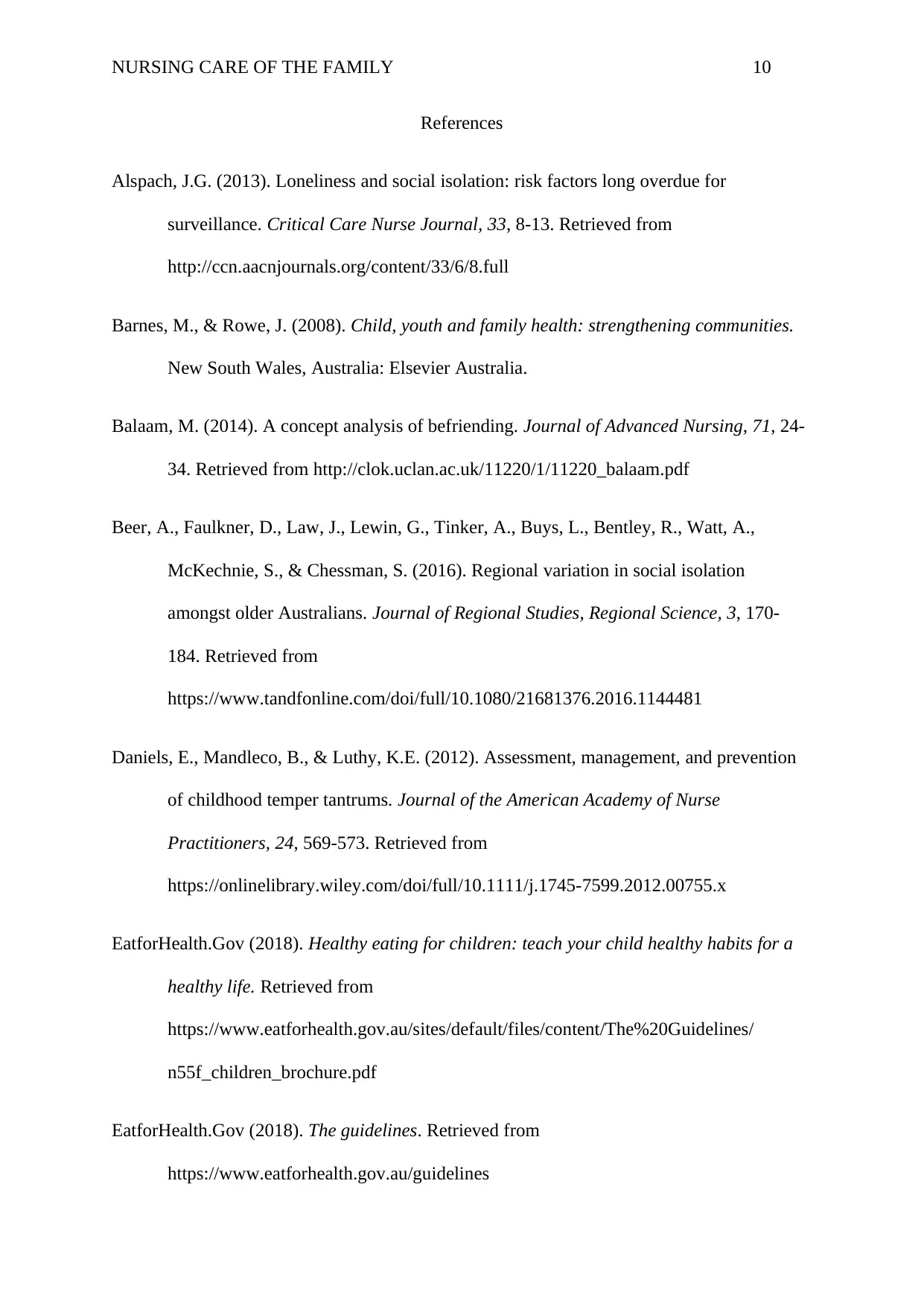
NURSING CARE OF THE FAMILY 10
References
Alspach, J.G. (2013). Loneliness and social isolation: risk factors long overdue for
surveillance. Critical Care Nurse Journal, 33, 8-13. Retrieved from
http://ccn.aacnjournals.org/content/33/6/8.full
Barnes, M., & Rowe, J. (2008). Child, youth and family health: strengthening communities.
New South Wales, Australia: Elsevier Australia.
Balaam, M. (2014). A concept analysis of befriending. Journal of Advanced Nursing, 71, 24-
34. Retrieved from http://clok.uclan.ac.uk/11220/1/11220_balaam.pdf
Beer, A., Faulkner, D., Law, J., Lewin, G., Tinker, A., Buys, L., Bentley, R., Watt, A.,
McKechnie, S., & Chessman, S. (2016). Regional variation in social isolation
amongst older Australians. Journal of Regional Studies, Regional Science, 3, 170-
184. Retrieved from
https://www.tandfonline.com/doi/full/10.1080/21681376.2016.1144481
Daniels, E., Mandleco, B., & Luthy, K.E. (2012). Assessment, management, and prevention
of childhood temper tantrums. Journal of the American Academy of Nurse
Practitioners, 24, 569-573. Retrieved from
https://onlinelibrary.wiley.com/doi/full/10.1111/j.1745-7599.2012.00755.x
EatforHealth.Gov (2018). Healthy eating for children: teach your child healthy habits for a
healthy life. Retrieved from
https://www.eatforhealth.gov.au/sites/default/files/content/The%20Guidelines/
n55f_children_brochure.pdf
EatforHealth.Gov (2018). The guidelines. Retrieved from
https://www.eatforhealth.gov.au/guidelines
References
Alspach, J.G. (2013). Loneliness and social isolation: risk factors long overdue for
surveillance. Critical Care Nurse Journal, 33, 8-13. Retrieved from
http://ccn.aacnjournals.org/content/33/6/8.full
Barnes, M., & Rowe, J. (2008). Child, youth and family health: strengthening communities.
New South Wales, Australia: Elsevier Australia.
Balaam, M. (2014). A concept analysis of befriending. Journal of Advanced Nursing, 71, 24-
34. Retrieved from http://clok.uclan.ac.uk/11220/1/11220_balaam.pdf
Beer, A., Faulkner, D., Law, J., Lewin, G., Tinker, A., Buys, L., Bentley, R., Watt, A.,
McKechnie, S., & Chessman, S. (2016). Regional variation in social isolation
amongst older Australians. Journal of Regional Studies, Regional Science, 3, 170-
184. Retrieved from
https://www.tandfonline.com/doi/full/10.1080/21681376.2016.1144481
Daniels, E., Mandleco, B., & Luthy, K.E. (2012). Assessment, management, and prevention
of childhood temper tantrums. Journal of the American Academy of Nurse
Practitioners, 24, 569-573. Retrieved from
https://onlinelibrary.wiley.com/doi/full/10.1111/j.1745-7599.2012.00755.x
EatforHealth.Gov (2018). Healthy eating for children: teach your child healthy habits for a
healthy life. Retrieved from
https://www.eatforhealth.gov.au/sites/default/files/content/The%20Guidelines/
n55f_children_brochure.pdf
EatforHealth.Gov (2018). The guidelines. Retrieved from
https://www.eatforhealth.gov.au/guidelines
Secure Best Marks with AI Grader
Need help grading? Try our AI Grader for instant feedback on your assignments.
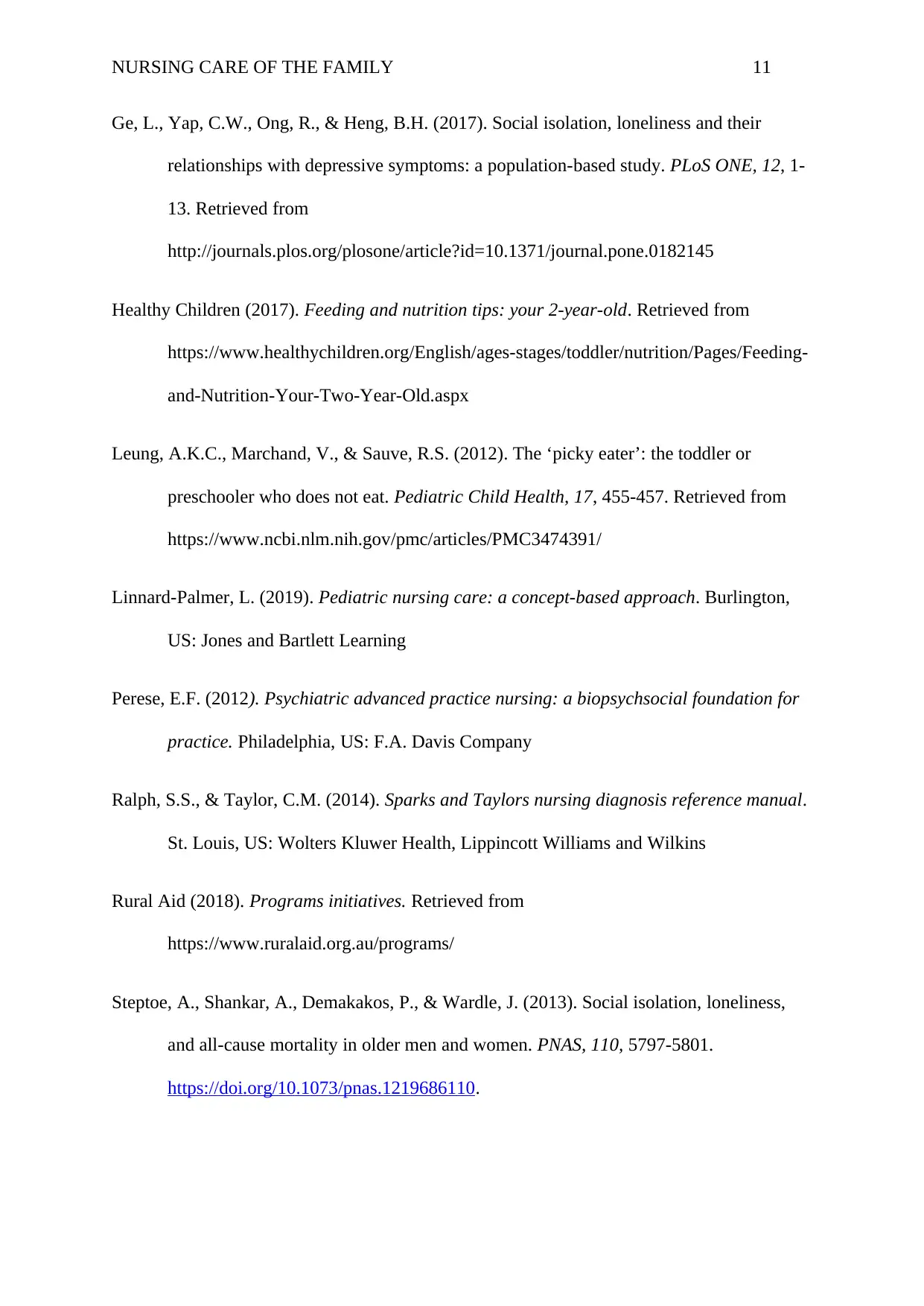
NURSING CARE OF THE FAMILY 11
Ge, L., Yap, C.W., Ong, R., & Heng, B.H. (2017). Social isolation, loneliness and their
relationships with depressive symptoms: a population-based study. PLoS ONE, 12, 1-
13. Retrieved from
http://journals.plos.org/plosone/article?id=10.1371/journal.pone.0182145
Healthy Children (2017). Feeding and nutrition tips: your 2-year-old. Retrieved from
https://www.healthychildren.org/English/ages-stages/toddler/nutrition/Pages/Feeding-
and-Nutrition-Your-Two-Year-Old.aspx
Leung, A.K.C., Marchand, V., & Sauve, R.S. (2012). The ‘picky eater’: the toddler or
preschooler who does not eat. Pediatric Child Health, 17, 455-457. Retrieved from
https://www.ncbi.nlm.nih.gov/pmc/articles/PMC3474391/
Linnard-Palmer, L. (2019). Pediatric nursing care: a concept-based approach. Burlington,
US: Jones and Bartlett Learning
Perese, E.F. (2012). Psychiatric advanced practice nursing: a biopsychsocial foundation for
practice. Philadelphia, US: F.A. Davis Company
Ralph, S.S., & Taylor, C.M. (2014). Sparks and Taylors nursing diagnosis reference manual.
St. Louis, US: Wolters Kluwer Health, Lippincott Williams and Wilkins
Rural Aid (2018). Programs initiatives. Retrieved from
https://www.ruralaid.org.au/programs/
Steptoe, A., Shankar, A., Demakakos, P., & Wardle, J. (2013). Social isolation, loneliness,
and all-cause mortality in older men and women. PNAS, 110, 5797-5801.
https://doi.org/10.1073/pnas.1219686110.
Ge, L., Yap, C.W., Ong, R., & Heng, B.H. (2017). Social isolation, loneliness and their
relationships with depressive symptoms: a population-based study. PLoS ONE, 12, 1-
13. Retrieved from
http://journals.plos.org/plosone/article?id=10.1371/journal.pone.0182145
Healthy Children (2017). Feeding and nutrition tips: your 2-year-old. Retrieved from
https://www.healthychildren.org/English/ages-stages/toddler/nutrition/Pages/Feeding-
and-Nutrition-Your-Two-Year-Old.aspx
Leung, A.K.C., Marchand, V., & Sauve, R.S. (2012). The ‘picky eater’: the toddler or
preschooler who does not eat. Pediatric Child Health, 17, 455-457. Retrieved from
https://www.ncbi.nlm.nih.gov/pmc/articles/PMC3474391/
Linnard-Palmer, L. (2019). Pediatric nursing care: a concept-based approach. Burlington,
US: Jones and Bartlett Learning
Perese, E.F. (2012). Psychiatric advanced practice nursing: a biopsychsocial foundation for
practice. Philadelphia, US: F.A. Davis Company
Ralph, S.S., & Taylor, C.M. (2014). Sparks and Taylors nursing diagnosis reference manual.
St. Louis, US: Wolters Kluwer Health, Lippincott Williams and Wilkins
Rural Aid (2018). Programs initiatives. Retrieved from
https://www.ruralaid.org.au/programs/
Steptoe, A., Shankar, A., Demakakos, P., & Wardle, J. (2013). Social isolation, loneliness,
and all-cause mortality in older men and women. PNAS, 110, 5797-5801.
https://doi.org/10.1073/pnas.1219686110.
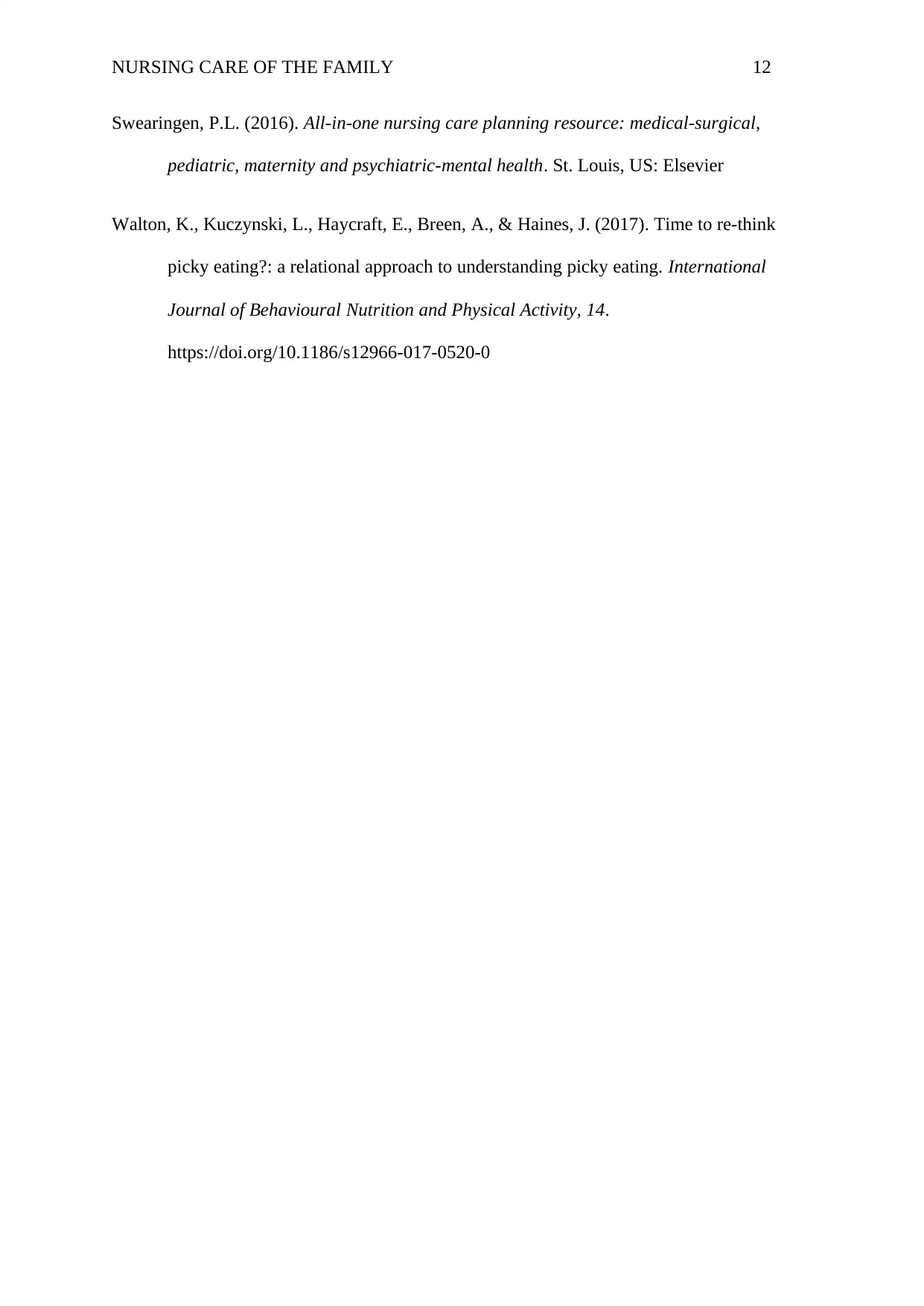
NURSING CARE OF THE FAMILY 12
Swearingen, P.L. (2016). All-in-one nursing care planning resource: medical-surgical,
pediatric, maternity and psychiatric-mental health. St. Louis, US: Elsevier
Walton, K., Kuczynski, L., Haycraft, E., Breen, A., & Haines, J. (2017). Time to re-think
picky eating?: a relational approach to understanding picky eating. International
Journal of Behavioural Nutrition and Physical Activity, 14.
https://doi.org/10.1186/s12966-017-0520-0
Swearingen, P.L. (2016). All-in-one nursing care planning resource: medical-surgical,
pediatric, maternity and psychiatric-mental health. St. Louis, US: Elsevier
Walton, K., Kuczynski, L., Haycraft, E., Breen, A., & Haines, J. (2017). Time to re-think
picky eating?: a relational approach to understanding picky eating. International
Journal of Behavioural Nutrition and Physical Activity, 14.
https://doi.org/10.1186/s12966-017-0520-0
1 out of 12
Your All-in-One AI-Powered Toolkit for Academic Success.
+13062052269
info@desklib.com
Available 24*7 on WhatsApp / Email
![[object Object]](/_next/static/media/star-bottom.7253800d.svg)
Unlock your academic potential
© 2024 | Zucol Services PVT LTD | All rights reserved.

